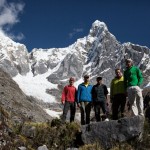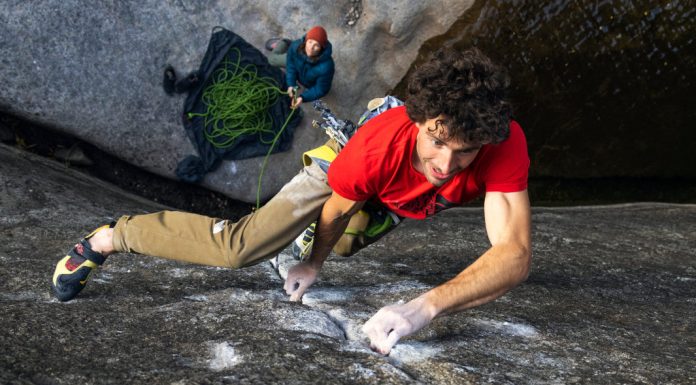by Jack Geldard & Iain Miller Iain Miller and Ross Jones have freed Testament to the Insane (XS 5b, 470m) on St. John´s Head in Orkney in a12 hour push.A full photo topo is available on orkney-seastacks.co.uk The route was first climbed by Derren Fox, Ross I. Jones, Iain Miller & Les Gorhamover in 2004. It was an epic 26 hour ascent, involving a short bivvy. An 8m leader fall was taken on pitch 8 and one point of aid used on lead, the pitch was then freed at 5b by the 2nd. On the recent free ascent, the team straightened out the first and last pitches, taking a more direct line. Pitch 8 was this time overcome without recourse to aid. The team described the route thus:”Rock quality is in general poor but the location and the atmosphere is truly outstanding, an adventurous and serious route.”St. John´s Head is thelargest vertical sea cliff in the UK, rising to a height of over 350m. The cliff is home to only four routes: The OriginalRoute, Longhope Route, Big John and Testament to the Insane. The OriginalRoute and Longhope Route were multi day undertakings climbed in 1969 and 1970 – EdDrummondhad spent seven days aiding up the Longhope Route, sleeping ina hammock – his route remained unrepeated for 27 years, until John Arran and Dave ´BMC´ Turnbull repeated it free over four daysat a mighty E7 6c – perhaps the most difficult adventure route in the UK. Big John is based on the impressive left arête of the north face and Testament to the Insane tackles a huge steep stepped arête at the southern end of St John´s Head. Orkney is an archipelago of over 70 islands, of which 17 are currently inhabited. They are mainly quite flat, however the island of Hoy is an exception, rising to 477 metres above sea level andguarded by huge sea cliffs – offering massive new route potential. The broken nature of the rock means the routes are extremely adventurous, and the large ledge systems provide ample nesting sites for birds. The fertile sea provides plenty offood and as a result Orkney´s cliffs support thousands of pairs ofbreeding sea birds, including puffins, guillemots, razorbills, fulmars, kittiwakes, gannets and bonxies. Loose rock could be the least of your worries. Most climbers visit the island to climb the famous sea stack The Old Man of Hoy. More info in the UKC Article Here.
- Home
- News
- Videos
- Fotos
- Klettergebiete
- Unternehmen & Produkte
- Themen
- Themen beginnend mit 0-9
- Themen beginnend mit A
- Themen beginnend mit B
- Themen beginnend mit C
- Themen beginnend mit D
- Themen beginnend mit E
- Themen beginnend mit F
- Themen beginnend mit G
- Themen beginnend mit H
- Themen beginnend mit I
- Themen beginnend mit J
- Themen beginnend mit K
- Themen beginnend mit L
- Themen beginnend mit M
- Themen beginnend mit N
- Themen beginnend mit O
- Themen beginnend mit P
- Themen beginnend mit Q
- Themen beginnend mit R
- Themen beginnend mit S
- Themen beginnend mit T
- Themen beginnend mit U
- Themen beginnend mit V
- Themen beginnend mit W
- Themen beginnend mit X
- Themen beginnend mit Y
- Themen beginnend mit Z
- Routendatenbank
Climbing.de ist eine der ältesten deutschsprachigen Bergsportseiten im Internet.
Seit 1998 präsentiert Inhaber Martin Joisten, dessen Texte und Bilder in zahlreichen nationalen und internationalen Publikationen zu finden sind, aktuelle Informationen aus der Welt des Bergsports.
Seit 1998 präsentiert Inhaber Martin Joisten, dessen Texte und Bilder in zahlreichen nationalen und internationalen Publikationen zu finden sind, aktuelle Informationen aus der Welt des Bergsports.
Kontaktieren Sie uns: info@climbing.de
© Copyright 1998 - 2022 Climbing.de by Martin Joisten


![[VIDEO] Alexander Megos: URSUS | The days after the send URSUS | The days after the send (c) Alexander Megos](https://www.climbing.de/wp-content/uploads/2024/03/youtube_WCZVR9-tZTc-218x150.jpg)

![[VIDEO] Stefano Ghisolfi: ALL my secrets about ENDURANCE Stefano Ghisolfi: ALL my secrets about ENDURANCE (c) Stefano Ghisolfi](https://www.climbing.de/wp-content/uploads/2024/03/youtube_xlQ2OreHL60-218x150.jpg)
![[VIDEO] THE FULL JOURNEY 9B FA by Alexander Megos THE FULL JOURNEY 9B FA by Alexander Megos (c) Alexander Megos](https://www.climbing.de/wp-content/uploads/2022/12/youtube_QwjykRehg7M-218x150.jpg)
![[VIDEO] MEGATRON V17 MEGATRON V17 (c) mellow](https://www.climbing.de/wp-content/uploads/2022/12/youtube_f_MniTA8MYU-218x150.jpg)
![[VIDEO] Moulin Rouge (7b) Free Solo | Jonas Hainz Moulin Rouge - Free Solo (c) Jonas Hainz](https://www.climbing.de/wp-content/uploads/2022/10/youtube_UQs4KNRBHss-218x150.jpg)

![[VIDEO] Jan Hojer bouldert in Südafrika](https://www.climbing.de/wp-content/uploads/2014/12/vimeo_47555959-150x150.jpg)










